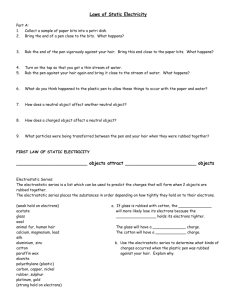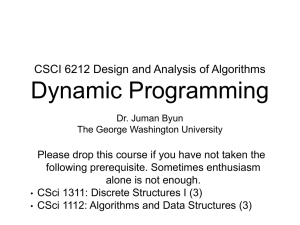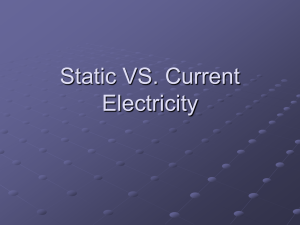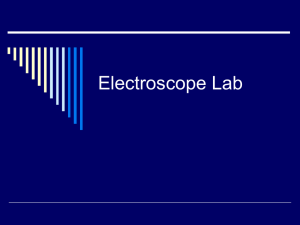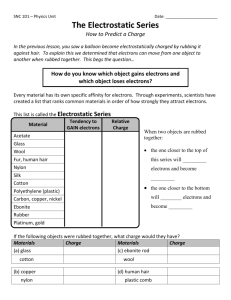Energy Quiz # 2 Study Guide and Practice Questions
advertisement
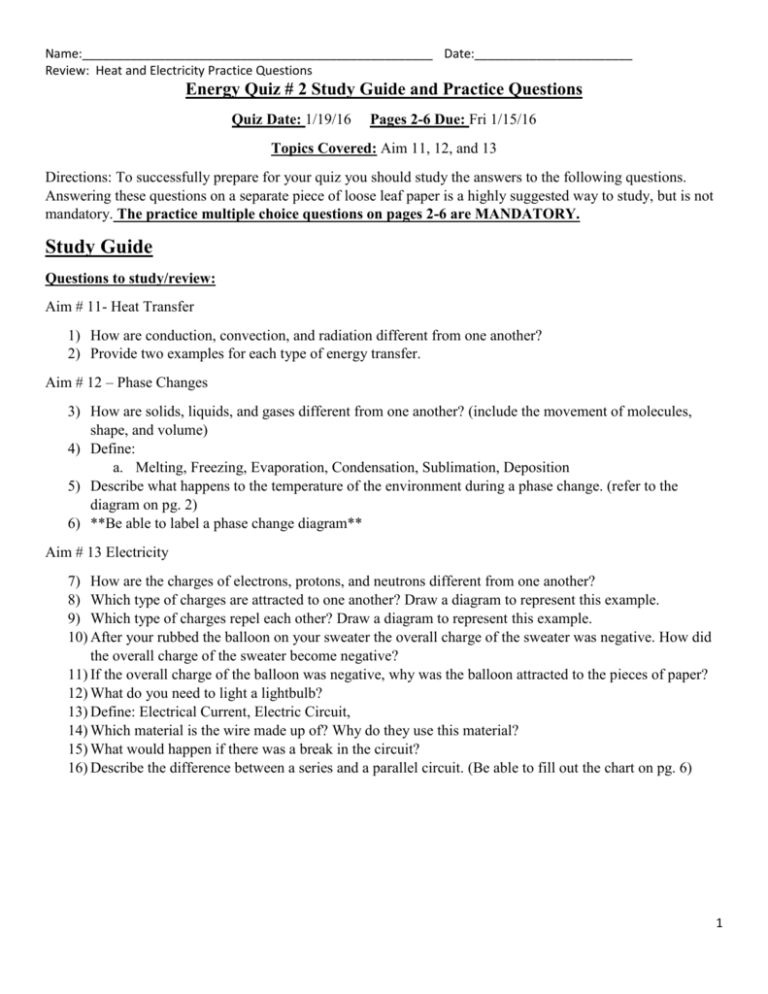
Name:___________________________________________________ Date:_______________________ Review: Heat and Electricity Practice Questions Energy Quiz # 2 Study Guide and Practice Questions Quiz Date: 1/19/16 Pages 2-6 Due: Fri 1/15/16 Topics Covered: Aim 11, 12, and 13 Directions: To successfully prepare for your quiz you should study the answers to the following questions. Answering these questions on a separate piece of loose leaf paper is a highly suggested way to study, but is not mandatory. The practice multiple choice questions on pages 2-6 are MANDATORY. Study Guide Questions to study/review: Aim # 11- Heat Transfer 1) How are conduction, convection, and radiation different from one another? 2) Provide two examples for each type of energy transfer. Aim # 12 – Phase Changes 3) How are solids, liquids, and gases different from one another? (include the movement of molecules, shape, and volume) 4) Define: a. Melting, Freezing, Evaporation, Condensation, Sublimation, Deposition 5) Describe what happens to the temperature of the environment during a phase change. (refer to the diagram on pg. 2) 6) **Be able to label a phase change diagram** Aim # 13 Electricity 7) How are the charges of electrons, protons, and neutrons different from one another? 8) Which type of charges are attracted to one another? Draw a diagram to represent this example. 9) Which type of charges repel each other? Draw a diagram to represent this example. 10) After your rubbed the balloon on your sweater the overall charge of the sweater was negative. How did the overall charge of the sweater become negative? 11) If the overall charge of the balloon was negative, why was the balloon attracted to the pieces of paper? 12) What do you need to light a lightbulb? 13) Define: Electrical Current, Electric Circuit, 14) Which material is the wire made up of? Why do they use this material? 15) What would happen if there was a break in the circuit? 16) Describe the difference between a series and a parallel circuit. (Be able to fill out the chart on pg. 6) 1 Name:___________________________________________________ Date:_______________________ Review: Heat and Electricity Practice Questions Practice Questions: Due Friday 1/15/16 1. The diagrams below represent three phases of matter, labeled A, B, and C. Which table correctly identifies the phases of matter represented by the diagrams? 2. Which process transfers heat when particles collide in a solid? (1) convection (3) radiation (2) conduction (4) evaporation 3. Diagram A below represents a solid metal rod before heating. Diagram B represents the same rod after heating for 5 minutes. The diameter of the rod is noted in both diagrams. Explain why the diameter of the metal rod changed slightly when the rod was heated. As the metal rod is heated, the molecules begin to move faster and start to spread out, causing the diameter to increase slightly 2 Name:___________________________________________________ Date:_______________________ Review: Heat and Electricity Practice Questions Base your answers to the following questions on diagrams A and B below and on your knowledge of science. Diagram A represents a glass of water containing ice cubes. As the water and glass cooled, droplets formed on the outside of the glass. Diagram B represents the same undisturbed glass of water two days later. 4. Complete the chart below by identifying the phase change that caused each event. Condensation (gas to liquid) Melting (solid to liquid) Evaporation (liquid to gas) 5. Explain why the ice floats in the liquid water in diagram A. Ice is less dense than liquid water ____________________________________________________________________________________ 6. How is this property of water different than the convection currents caused by heat transfer in other substances, for example the magma in Earth’s mantle, or the gases that make up air in the Earth’s atmosphere. Most substances become more dense when cooled. Water has special properties that make ice less dense than water. 7. Because copper is a metal, it is (1) liquid at room temperature (2) nonreactive with other substances (3) a poor conductor of electricity (4) a good conductor of heat 3 Name:___________________________________________________ Date:_______________________ Review: Heat and Electricity Practice Questions 8. All of the liquid from a test tube is poured into a beaker, as shown in the diagram below. Compared to the liquid that was in the test tube, the liquid in the beaker has (1) a different volume, but the same shape (2) a different volume and a different shape (3) the same volume, but a different shape (4) the same volume and the same shape 9. When a balloon is rubbed on a wool sweater, the balloon builds up a negative electrical charge. When a glass rod is rubbed on silk, the rod builds up a positive electrical charge. Explain why the charged balloon will be attracted to the charged glass rod. The opposite charges are attracted to each other. ____________________________________________________________________________________ 10. The arrows in the diagram below show the circulation of air on a sunny day. The air circulation shown is caused by (1) both hot air and cool air sinking (2) both hot air and cool air rising (3) hot air sinking and cool air rising (4) hot air rising and cool air sinking 4 Name:___________________________________________________ Date:_______________________ Review: Heat and Electricity Practice Questions Base your answers to the following questions on the diagram below and on your knowledge of science. The diagram represents four processes, labeled A, B, C, and D, that occur when water changes phase. 11. Which process is represented by B? (1) condensing (2) evaporating (3) freezing (4) melting 12. Which two processes increase the motion of the molecules? (1) A and B (3) C and D (2) B and C (4) D and A 13. The diagram below shows a game where players try to move a metal needle through three metal paper clips without letting the needle touch the clips. A bulb lights when the needle touches a paper clip, signaling that the player has lost. Why does the bulb light when the needle touches a paper clip? (1) Convection cells are produced. (3) A circuit is completed. (2) Vibrations set up wavelike disturbances. (4) A phase change occurs. 14. Compared to the particles in a hardened lava sample, the particles in a liquid lava sample (1) have a lower temperature (2) have less kinetic energy (3) are moving faster (4) are closer together 15. A boy pulls a sweater off over his head. His hair is attracted to the sweater due to (1) a magnetic force (2) a heat transfer (3) a chemical change (4) an electrical charge 5 Name:___________________________________________________ Date:_______________________ Review: Heat and Electricity Practice Questions 16. Compare a series and parallel circuit. In your answer be sure to include: Series Parallel How does energy flow? Only one path for e- to flow Multiple paths for e- to flow Flashlight Houses or cars As you add lights, they become dimmer Lights stay the same brightness They all go out The other lights stay on Give one example. As you add light bulbs, what happens to the brightness of each bulb? What happens if one bulb goes out? Sketch a picture (label the power source, the light bulb, and the wire) 6

